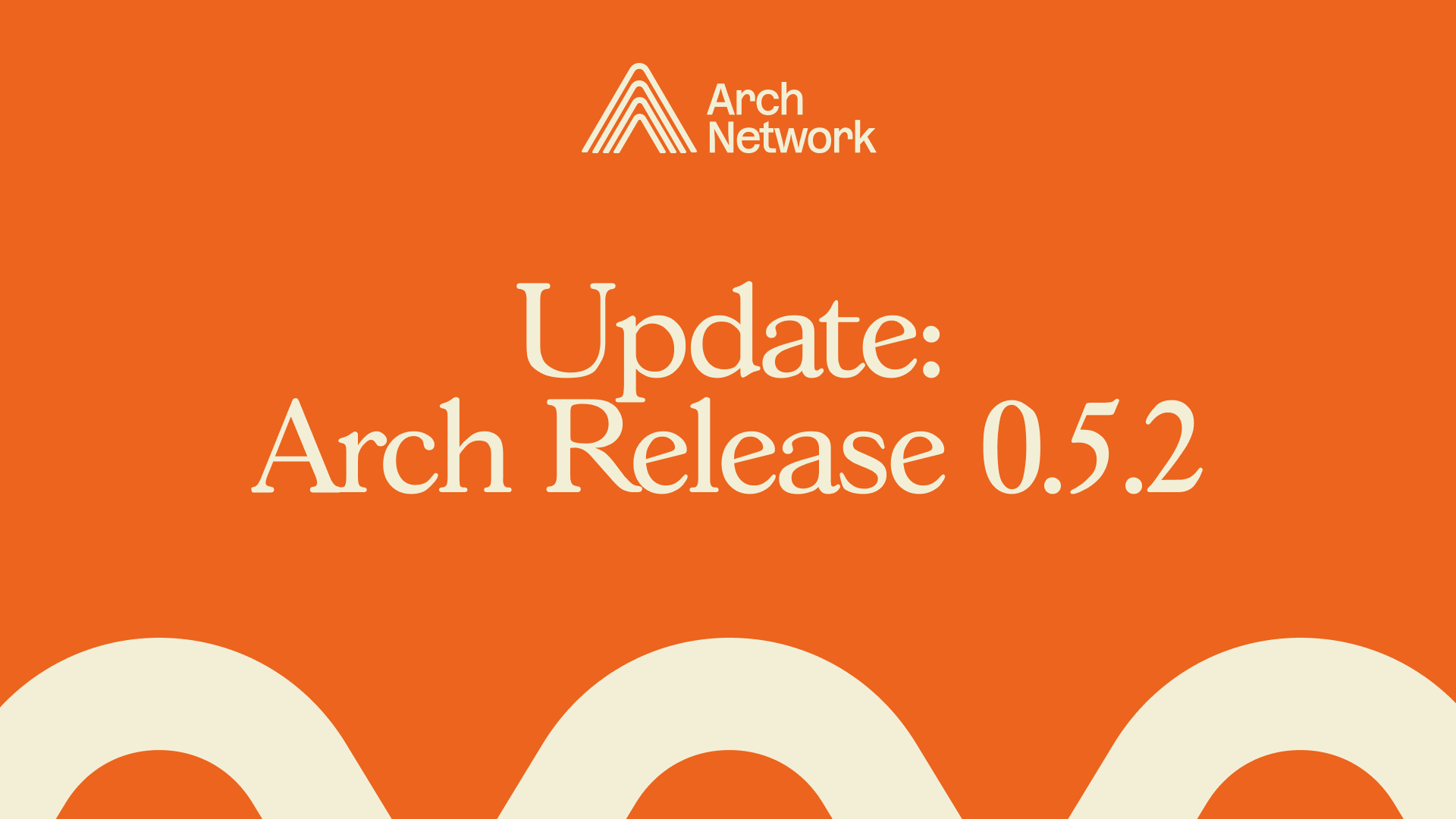Bringing Scalable Performance to Bitcoin

Our latest update brings fundamental infrastructure improvements that make building on Bitcoin faster, more reliable, and ready for serious applications.
Bitcoin programmability has been a dream for over a decade. The vision of smart contracts running with Bitcoin's security and decentralization has captivated developers and users alike. But until now, the infrastructure to make this dream practical has been missing.
That's changing with Arch and in particular, our latest release.
While the Bitcoin community debates features like OP_RETURN and how to enable programmability without compromising Bitcoin's core principles, we've been quietly building the infrastructure that makes it all possible.
This release represents months of engineering work focused on three fundamental improvements that transform what's possible when building on Bitcoin.
Check out the full details on Github here.
File-Based Database Architecture: Performance That Scales
The most significant change in this release is a significant overhaul of how data is stored and accessed. We've moved from a traditional database model to a sophisticated file-based indexing system that fundamentally changes how Arch Network handles account data and transaction history.
This update changes how we handle blockchain data with Bitcoin as the foundation. Rather than keeping everything in memory or using standard database methods, the new system stores account states and transaction reports in optimized files with faster indexing.
The result is dramatic performance improvements across the board. Account lookups that used to require multiple database queries now happen with direct file access. Transaction processing that could slow down under heavy load now maintains consistent speed regardless of network activity. Most importantly, the system can now handle the kind of transaction volumes that serious financial applications require.
This architecture also makes Arch Network more resilient. Data integrity is maintained through sophisticated serialization and indexing systems that ensure consistency even during network disruptions or unexpected shutdowns.
Bulletproof Synchronization: Network Reliability Redefined
Network synchronization has always been one of the trickiest aspects of blockchain infrastructure. When nodes go offline, when transactions need to be rolled back, when the network experiences temporary splits — things can go wrong quickly.
Our new synchronization system changes that reality entirely. We've built comprehensive rollback and reapplication mechanisms that can handle virtually any scenario the network might encounter. When transactions need to be undone due to Bitcoin blockchain reorganizations, the system automatically reverts all affected state changes and cleanly reapplies valid transactions.
But the real breakthrough is in how gracefully the system handles network interruptions. Nodes that lose connection to the Bitcoin network or to other Arch validators can automatically recover their state when they reconnect. The system intelligently determines what transactions need to be rolled back, what needs to be reapplied and how to get back in sync without manual intervention.
This level of reliability is essential for any serious application. DeFi protocols can't afford to have an inconsistent state. Payment systems can't tolerate data corruption. Enterprise applications demand enterprise-grade reliability. With these improvements, Arch Network delivers exactly that.
Memory Optimization: Smart Resource Management
Behind the scenes, we've implemented sophisticated memory management improvements that might not be visible to developers but make a huge difference in performance and reliability.
The key breakthrough involves eliminating unnecessary heap allocations in critical execution paths, particularly in system calls that interact with Bitcoin transaction data. Instead of dynamically allocating memory for every operation we now use fixed-size data structures that are both faster and more predictable.
This change might sound technical but its impact is substantial. Applications can handle more concurrent users. Validators can process more transactions per second. Memory usage remains stable even during periods of high activity. The entire network becomes more predictable and reliable.
CLI Tools That Actually Work: Developer Experience Transformed
Another major pain point for developers working with blockchain infrastructure has always been the tooling. Setting up test environments, deploying to different networks, managing configurations — these tasks often require deep technical knowledge and custom scripts that break at the worst possible moments.
We've completely rethought our command-line interface to solve these problems. The new CLI includes powerful deployment commands that can spin up entire validator networks with a single command. No more manual configuration files, no more fragile shell scripts, no more debugging obscure setup issues.
The orchestration tools are where things get really interesting. You can now deploy complex multi-container setups for testing and development with commands that actually make sense.
But what developers will really appreciate is how the CLI handles the day-to-day workflow. Deploying your programs to testnet is now much easier and intuitive than it was previously. We will continue to update and improve the CLI based on feedback and the new feature pipeline.
Why This Matters for Bitcoin's Future
These improvements represent more than incremental progress. They establish Arch Network as production-ready infrastructure for building the next generation of Bitcoin applications.
For the first time, developers can build sophisticated financial applications on Bitcoin with confidence that the underlying infrastructure will support them at scale. DeFi protocols can handle high-frequency trading. Payment systems can process thousands of transactions per second. Enterprise applications can meet enterprise reliability standards.
Most importantly all of this happens without requiring any changes to Bitcoin itself. We're not asking Bitcoin to be something it's not. We're building the programmability layer that lets Bitcoin be everything it can be.
The infrastructure improvements in this release make one thing clear: the era of Bitcoin programmability isn't coming someday. It's here now. The foundation is solid. The performance is proven. The reliability is enterprise-grade.
What gets built on this foundation is up to the developers and entrepreneurs who see Bitcoin not just as digital gold, but as the base layer for a new financial system.
The tools are ready. The infrastructure is proven. The future of Bitcoin applications starts with what you build today.
Ready to start building? Explore our documentation, join our community, and become part of Bitcoin's programmable future.

